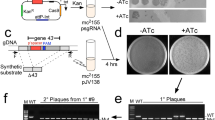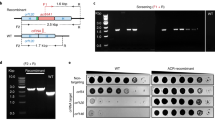Abstract
Bacteriophage Cr30 has proven useful for the transduction of Caulobacter crescentus. Nucleotide sequencing of Cr30 DNA revealed that the Cr30 genome consists of 155,997 bp of DNA that codes for 287 proteins and five tRNAs. In contrast to the 67 % GC content of the host genome, the GC content of the Cr30 genome is only 38 %. This lower GC content causes both the codon usage pattern and the amino acid composition of the Cr30 proteins to be quite different from those of the host bacteria. As a consequence, the Cr30 mRNAs probably are translated at a rate that is slower than the normal rate for host mRNAs. A phylogenetic comparison of the genome indicates that Cr30 is a member of the T4-like family that is most closely related to a new group of T-like phages exemplified by фM12.


Similar content being viewed by others
References
Agabian-Keshishian N, Shapiro L (1970) Stalked bacteria: properties of deoxyribonucleic acid bacteriophage фCBK. J Virol 5:795–800
Altschul SF, Gish W, Miller W, Myers EW, Lipman DJ (1990) Basic local alignment search tool. J Mol Biol 215:403–410. doi:10.1093/nar/25.17.3389
Ardissone S, Fumeaux C, Bergé M, Beaussart A, Théraulaz L, Radhakrishnan SK, Dufrêne YF, Viollier PH (2014) Cell cycle constraints on capsulation and bacteriophage susceptibility. Elife 3:e03587. doi:10.7554/eLife.03587.001
Aziz R, Bartels D, Best A, DeJongh M, Disz T, Edwards R et al (2008) The RAST server: rapid annotations using subsystems technology. BMC Genom 9:75. doi:10.1186/1471-2164-9-75
Barrett JT, Croft RH, Ferber DM, Gerardot CJ, Schoenlein PV, Ely B (1982) Genetic mapping with Tn5-derived auxotrophs of Caulobacter crescentus. J Bacteriol 151:888–898
Barrett JT, Rhodes CS, Ferber DM, Jenkins B, Kuhl SA, Ely B (1982) Construction of a genetic map for Caulobacter crescentus. J Bacteriol 149:869–876
Brewer TE, Stroupe ME, Jones K (2014) The genome, proteome and phylogenetic analysis of phage фM12, the founder of a new group of T4-super family phages. Virology 450–451:84–97. doi:10.1016/j.virol.2013.11.027
Carbone A (2008) Codon bias is a major factor explaining phage evolution in translationally biased hosts. J Mol Evol 66:210–223. doi:10.1007/s00239-008-9068-6
Cruveiller S, Le Saux J, Vallenet D, Lajus A, Bocs S, Médigue C (2005) MICheck: a web tool for fast check of syntactic annotations of bacterial genomes. Nucleic Acids Res 33:W471–W479. doi:10.1093/nar/gki498 (Web Server issue)
Dingwall A, Shapiro L, Ely B (1990) Analysis of bacterial genome organization and replication using pulsed-field gel electrophoresis. Methods 1:160–168. doi:10.1016/S1046-2023(05)80131-8
Ely B (1990) The Caulobacter crescentus genetic map. Genet Maps 5:2.100–2.103
Ely B (1991) Genetics of Caulobacter crescentus. In: Miller JH (ed) Bacterial genetics systems. methods in enzymology, vol 204. Academic Press, San Diego, pp 372–384. doi:10.1016/0076-6879(91)04019-K
Ely B, Johnson RC (1977) Generalized transduction in Caulobacter crescentus. Genetics 87:391–399
Gill JJ, Berry JD, Russell WK, Lessor L, Escobar-Garcia DA, Hernandez D et al (2012) The Caulobacter crescentus bacteriophage phiCbK: genomics of a canonical phage. BMC Genom 13:542
Goldsmith DB, Crosti G, Dwivedi B, McDaniel LD, Varsani A, Suttle CA, Weinbauer MG, Sandaa RA, Breitbart M (2011) Development of phoH as a novel signature gene for assessing marine phage diversity. Appl Environ Microbiol 77(21):7730–7739. doi:10.1128/AEM.05531-11
Guerrero-Ferreira RC, Viollier PH, Ely B, Poindexter JS, Georgieva M, Jensen GJ, Wright ER (2011) A novel mechanism for bacteriophage adsorption to the motile bacterium Caulobacter crescentus. Proc Nat Acad Sci USA 108:9963–9968. doi:10.1073/pnas.1012388108
Johnson RC, Wood NB, Ely B (1977) Isolation and characterization of bacteriophages for Caulobacter crescentus. J Gen Virol 37:323–335. doi:10.1099/0022-1317-37-2-323
Lightfield J, Fram NR, Ely B (2011) Across bacterial phyla distantly-related genomes with similar genomic GC content have similar patterns of amino acid usage. PLoS One 6(3):e17677
Lucks JB, Nelson DR, Kudla GR, Plotkin JB (2008) Genome landscapes and bacteriophage codon use. PLoS Comput Biol 4(2):e1000001. doi:10.1371/journal.pcbi.1000001
Mann NH, Clokie MR, Millard A, Cook A, Wilson WH, Wheatley PJ et al (2005) The genome of S-PM2, a ‘photosynthetic’ T4-type bacteriophage that infects marine Synechococcus. J Bacteriol 187:3188–3320
Miller ES, Heidelberg JF, Eisen JA, Nelson WC, Durkin AS, Ciecko A et al (2003) Complete genome sequence of the broad-host-range vibriophage KVP40: comparative genomics of a T4-related bacteriophage. J Bacteriol 185:5220–5233
Miller ES, Kutter E, Mosig G, Arisaka F, Kunisawa T, Ruger W (2003) Bacteriophage T4 genome. Microbiol Mol Biol Rev 67:86–156
Nolan JM, Petrov V, Bertrand C, Krisch HM, Karam JD (2006) Genetic diversity among five T4-like bacteriophages. Virol J 3:30
Petrov VM, Nolan JM, Bertrand C, Levy D, Desplats C, Krisch HM, Karam JD (2006) Plasticity of the gene functions for DNA replication in the T4-like phages. J Mol Biol 361:46–68
Pope WH, Hua J, Hatfull GF, Hendrix RW (2012) Sequence of the genome of sphingomonas phage PAU. In: National Center for Biotechnology Information. www.ncbi.nlm.nih.gov. Accessed 2 Feb 2015
Rutherford K, Parkhill J, Crook J, Horsnell T, Rice P, Rajandream MA, Barrell B (2000) Artemis: sequence visualization and annotation. Bioinformatics 16(10):944–945. doi:10.1093/bioinformatics/16.10.944
Schattner P, Brooks AN, Lowe TM (2005) The tRNAscan-SE, snoscan and snoGPS web servers for the detection of tRNAs and snoRNAs. Nucleic Acids Res 33:W686–W689. doi:10.1093/nar/gki366
Sullivan MB, Coleman M, Weigele P, Rohwer F, Chisholm SW (2005) Three Prochlorococcus cyanophage genomes: signature features and ecological interpretations. PLoS Biol 3:e144
Sullivan MB, Huang KH, Ignacio-Espinoza JC, Berlin AM, Kelly L, Weigele PR et al (2010) Genomic analysis of oceanic cyanobacterial myoviruses compared with T4-like myoviruses from diverse hosts and environments. Environ Microbiol 12(11):3035–3056. doi:10.1111/j.1462-2920.2010.02280.x
Weigele PR, Pope WH, Pedulla ML, Houtz JM, Smith AL, Conway JF et al (2007) Genomic and structural analysis of Syn9, a cyanophage infecting marine Prochlorococcus and Synechococcus. Environ Microbiol 9:1675–1695
Zhao Y, Temperton B, Thrash JC, Schwalbach MS, Vergin KL, Landry ZC, Ellisman M, Deerinck T, Sullivan MB, Giovannoni SJ (2013) Abundant SAR11 viruses in the ocean. Nature 494(7437):357–360. doi:10.1038/nature11921
Acknowledgments
This work was funded in part by National Science Foundation Grant EF-0826792 and NIH Grants R25GM066526 and R25GM076277 to BE.
Conflict of interest
The authors declare that there are no conflicts of interest.
Author information
Authors and Affiliations
Corresponding author
Rights and permissions
About this article
Cite this article
Ely, B., Gibbs, W., Diez, S. et al. The Caulobacter crescentus Transducing Phage Cr30 is a Unique Member of the T4-Like Family of Myophages. Curr Microbiol 70, 854–858 (2015). https://doi.org/10.1007/s00284-015-0799-5
Received:
Accepted:
Published:
Issue Date:
DOI: https://doi.org/10.1007/s00284-015-0799-5




